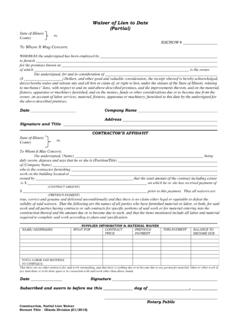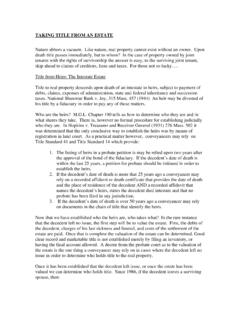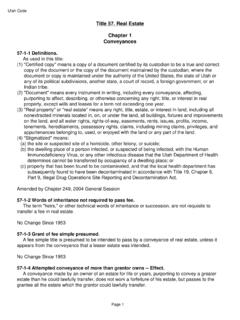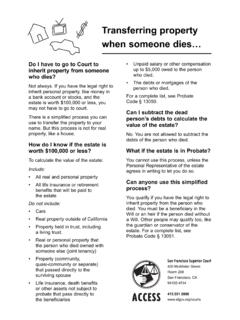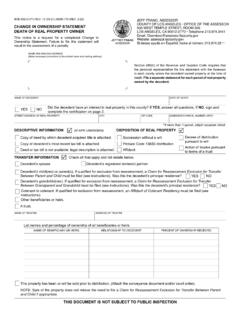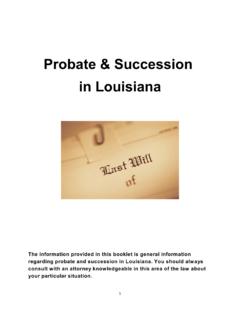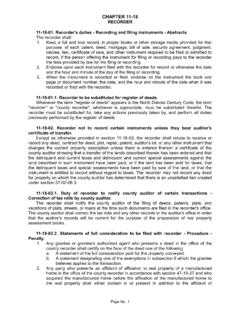Transcription of Texas Intestate Succession - Stewart
1 Texas Intestate Succession Please note: There are no substantive changes in these laws; effective January 1, 2014 code references are to the Estate Code rather than to the prior Probate Code. Property That May Descend Each and every title to every estate of inheritance, real , personal or mixed, owned by the Intestate decedent passes to the heir or heirs. (Estates Code ; et seq). This may include an interest in partnership property, an estate in co-tenancy, a right to a patent, or any other title or estate whether assignable or not during life and whether exempt or not from claims of creditors. Included is property acquired by limitation. Persons Who May Take The potential heirs in the line of statutory designation are children and their descendants, father and mother, brothers and sisters, and their descendants, grandfather and grandmother and their descendants and husband and wife.
2 (Estates Code ). If a person is a descendant of one who, if alive, would be an heir, and said person is made an heir by law then said person is an heir of his own right and not as an heir of the one of whom he is a descendant. The status of persons as heirs is fixed as of the date of the death of the Intestate from whom they inherit. This is because the title vests as of the date of death. Persons Who Take Upon Intestacy Intestate leaving no spouse: o Decedent s children or their descendants; or if none, then o Decedent s father and mother equally; or if only one parent survives, then Half to surviving parent and half to brothers and sisters and their descendants; If no surviving brothers, sisters or their descendants, then all to surviving parent. o If neither parent survives, then to brothers, sisters, and their descendants.
3 O If none of the above survive, then the estate is divided into two shares, one for paternal kindred and one for maternal kindred, as follows: Equal shares to the grandfather and grandmother, or if only one survives, then Half (one share) to surviving grandparent and half (one share) to descendants of deceased grandparent. If no descendants, all to surviving grandparent. If neither grandparent survives, all to their descendants. (Estates Code (g)(3)). Intestate leaving spouse: o Intestate s separate real property only. If children or their descendants also survive: Life Estate in one-third (1/3) to surviving spouse; and Remainder to children or their descendants and outright ownership of the other two-thirds (2/3) to children or their descendants. (Estates Code (b)(3)). If no children or their descendants survive: One-half (1/2) to surviving spouse; one-half (1/2) per rules of descent and distribution; provided If decedent has neither surviving father nor mother nor brothers or sisters or their descendants, then all to surviving spouse.
4 (Estates Code (d)). o Intestate s separate personal property only. If children or their descendants also survive: One-third (1/3) to surviving spouse; Two-thirds (2/3) to children and their descendants. (Estates Code (b)(3)). If no children or their descendants survive, then all to the surviving spouse. (Estates Code (d)). o Intestate s community estate. (Estates Code ). If no children or their descendants survive, then all to surviving spouse. Prior to September 1, 1993: If children or their descendants survive then One-half (1/2) of community estate to surviving spouse (the 1/2 the spouse already owns); and One-half (1/2) to children and their descendants. After September 1, 1993: If children or their descendants survive: If all surviving children and descendants of the deceased spouse are also children or descendants of the surviving spouse, then all to the surviving spouse.
5 If a surviving child or other descendant of the deceased spouse is not a child or descendant of the surviving spouse, then o One-half (1/2) of community estate is retained by the surviving spouse (the 1/2 the spouse already owns); and o One-half (1/2) to the children or descendants of the deceased spouse. Inheritance Rights of Children Maternal Inheritance (Estates Code ). A child is the child of his biological or adopted mother so that the child and the child s issue shall inherit from the mother and from the maternal kindred. Paternal Inheritance (Estates Code ). A child is the child of his biological father if the child is born under circumstances described by Section , Family Code, or is adjudicated to be the child of the father by court decree, or was adopted by his father, or if the father executed a statement of paternity as provided by law.
6 A person claiming to be a biological child of a decedent who is not otherwise presumed to be a child of the decedent, or claiming an inheritance through a biological child of the decedent, who is not otherwise presumed to be a child of the decedent, may petition to the probate court for a determination of right and inheritance. If the court finds by clear and convincing evidence that the purported father was the biological father of the child, the child is treated as any other child of the decedent. Reliance on Heirship Affidavit (Estates Code ). A person who purchases for valuable consideration any interest in real property of the heirs of a decedent, who in good faith relies on the declarations and affidavit of heirship that does not include a child who at the time of the sale or contract of sale of the property is not a presumed child of the decedent and has not under a final court decree or judgment been found to be entitled to treatment under this subsection as a child of the decedent, and who is without knowledge of the claim of that child, acquires good title to the interest that the child would have received, as purchaser, in the absence of any claim of the child not included in the affidavit.
7 Texas has adopted a statutory form of the Affidavit of Heirship. Another form may be used. Underwriting Standard: Be certain to act upon the information contained in the Affidavit of Heirship. Annulled Marriages Effect The issue of marriages declared void or voided by annulment shall be treated in the same manner as issue of a valid marriage. (Estates Code ). Half-Blood Heirs Collateral kindred of the half-blood inherit only half as much as collateral kindred of the full blood. (Estates Code ). This means that each individual related by half-blood gets only half as much as an heir in the same degree and being of whole blood. If all are of the half-blood they share equally. (Estates Code ) Heirs Apparent The status of the heirs is determined at the instant of death. One may be an heir apparent.
8 However, such heir apparent does not have a vested right in the expectancy. If the heir apparent dies, the expectancy as such does not descend; rather, its heirs become direct heirs by substitution in accordance with the statutes of descent and distribution and take per stirpes. Per Capita and Per Stirpes When the Intestate s children, or brothers, sisters, uncles, or aunts or any other relative standing in the first or same degree alone come into distribution upon intestacy, they shall take per capita, namely, by persons. If a part are living and a part are dead, the descendants of the deceased person take per stirpes. (Estates Code ). Therefore, if the Intestate is survived only by nephews and nieces of deceased brothers and sisters, such nieces and nephews take per capita. Murder of the Decedent by an Heir No conviction shall work corruption of blood or forfeiture of estate.
9 (Const. Art. I Section 21). (Estates Code ). Even if an heir murders the ancestor he will inherit the estate. However, in such case, the estate is taken subject to a constructive trust in favor of those heirs other than the one committing the murder. In other words, although the legal title passes in accordance with the statutes of descent and distribution, the actual beneficial title is in the other heirs and the murderer may be compelled by court order to convey the legal title to them. Furthermore, if one of the heirs in whose favor the trust is imposed should die leaving the murderer as his heir a further trust is imposed on the murderer s share. Suicides The estates of those who destroy their own lives shall descend or vest in case of natural death. (Estates Code ). Aliens No person is disqualified to take as an heir because he or a person through who he claims is or has been an alien.
10 (Estates Code ). Vesting of the Inheritance and Burdens Thereon o Effect of Recordation Statutes There is no actual transfer of title under descent and distribution as contemplated by the recordation statutes. In other words, the passage of such title is not reflected by the deed records nor may it be reflected in such manner as is provided for by the recordation statutes applicable to purchasers for value and creditors. (Property Code Sec. ). Title Examiners generally determine heirship rights either by examination of probate records or affidavits of facts which have been filed either in the deed records or other official records. o The Nature of the Title Which Passes The title does not change upon passage. It goes to the heir exactly as it existed in the ancestor. For example, if the property is community property in the husband s name alone, the wife s interest is an equity and it passes to her heirs as an equity.




